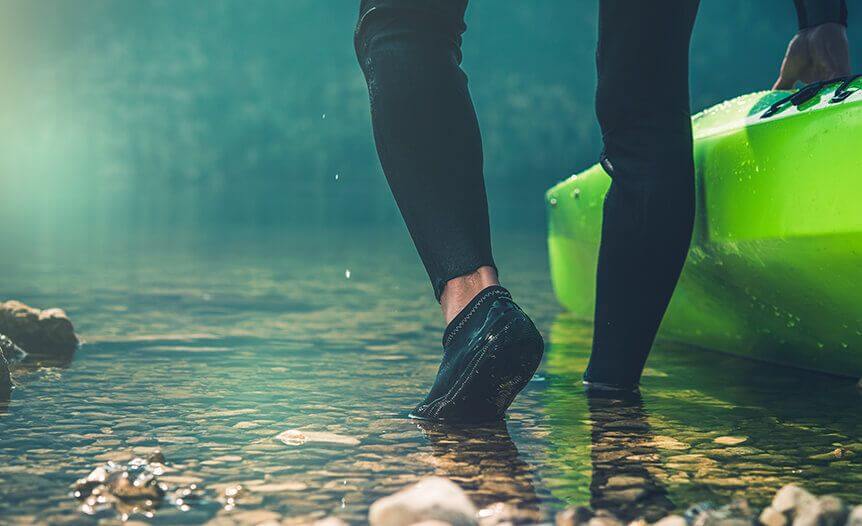Ultimate Guide to Kayaking with Kids
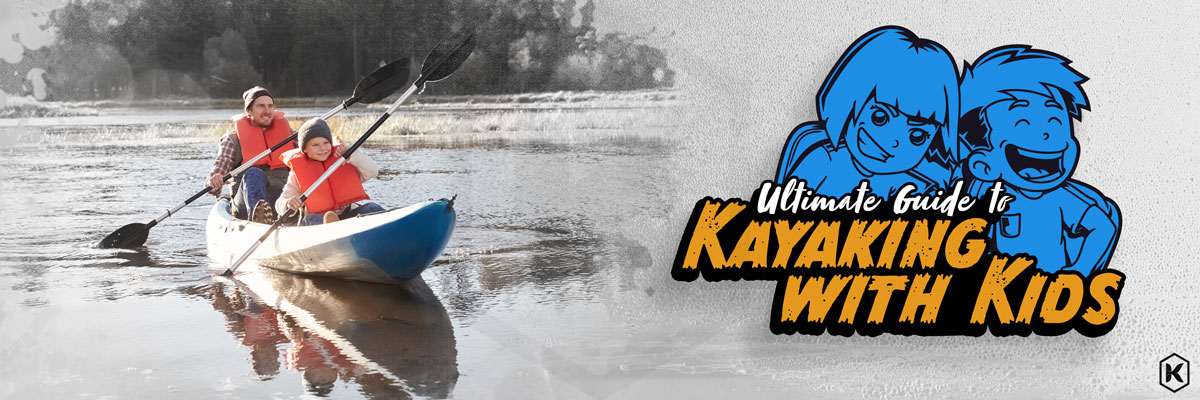
This ultimate guide covers everything you need to know about purchasing a kayak for your kids and teaching them how to operate it safely.
Kayaking with kids can be an excellent way to get them out into the wild. Kids can control a kayak from a reasonably young age, and this allows them to take charge and go where they want - under your watchful eye, of course!
If you have a kayak yourself, then you can start kayaking with your kids while they're still at a reasonably young age. Provided you have a good quality life jacket, they'll be safe and can ride on the front of most kayaks.
While no child will admit it, especially when they hit the dreaded teenage years, they love doing the things their parents like. If you're going out on the water regularly - or even if it's only every now and then - odds are they'll want to come along.
Teaching your kids about kayaking will mean they'll probably want a kayak of their own. In this article, we'll cover everything you need to know about buying a kayak for kids.
Getting started with kids in a kayak
Kayaking is a fun experience for everyone, but before buying a kids kayak, it is best to make sure they are interested in the activity. If you have a kayak already, your kids can sit on these while you paddle, providing you don't exceed the weight rating! Renting a kayak is another excellent option, and your kids can even have their own provided they are old enough.
If you're planning on taking extended kayaking trips, your kids should be reasonably confident swimmers. For the first few times, your kids are paddling, it may be best to choose a lake, as your kids won't have to paddle against tides and currents. Having a well-fitting life jacket is essential for kids, as these will help them get back on the kayak if they fall in the water.
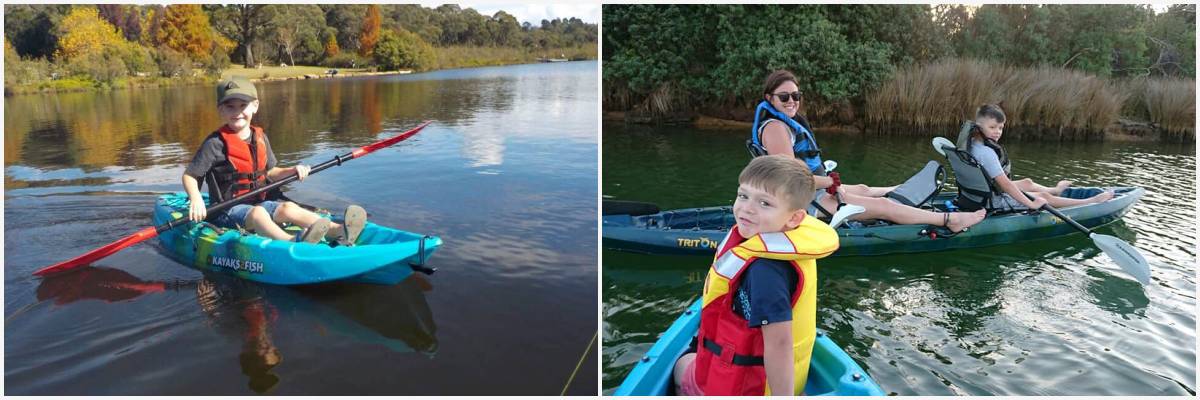
Kayaking with the entire family involved
One of the best things about kayaking is that anyone can do it. You can go as fast or as slow as you like, and there are kayaks to suit all ages and fitness levels. Kayaking is a highly adaptable sport. You can choose to do fishing, kayaking, sea kayaking, or river kayaking. Anywhere you can find water, you can head out with your kit and paddle.
In many suburbs all over Australia, you'll find a lake or pond suitable for kayaking - so you don't even need to drive that far to find a good spot!
When you're starting to go kayaking with kids, you may feel a little uneasy. If you're not confident about controlling a kayak and looking after your kids at the same time, you can head out with some other parents. You can find local kayak groups reasonably easily - thanks to social media - and by meeting up with others, you can get some excellent advice.
If you're starting out paddling around with your kids, it is best to have at least one adult per child. Ideally, you should go to a well-sheltered location and pick a day with little to no wind. Make sure your kids are well aware that they may end up in the water, and they're totally okay with that. You can always 'accidentally' fall in to show them that it'll be okay if it happens to them.
Where to go kayaking with kids
There are a few ways to find an excellent place to go kayaking with your kids. In all states of Australia, you'll find excellent sources of information about kayaking. Your first stop should be to your local tourism website to find what natural attractions are close by (e.g., Parks Victoria). These websites will give you information and advice about places to go, and they'll keep you informed about any local restrictions (current closures, etc.).
While you are learning to kayak, it is best to stick to small lakes and calm rivers. As you gain experience going kayaking with your kids and building on their skills, you can start looking at more advanced areas. Doing research on a lake nearby will give you a good guide for if that area is suitable.
You can visit any new location without the kayaks, check for a safe launching area and the overall conditions. When kayaking in new areas, make sure you check the toilet options and if food is available nearby. In most parks, there are BBQ places, and you can use those to make a whole day of it.
If you have an option to join a local kayaking group, you'll have the opportunity to talk with other kayakers. Using the knowledge of experienced kayakers is an excellent method for finding the perfect starter location.
If you are hiring a kayak for the weekend, ask them what the best places to go for people new to the sport. They often have a wealth of information, and as they get asked these questions a lot, they will have some brilliant options for you.
Planning is how you can make sure your kids have a good time while kayaking. Teach your kids how to spot the best kayaking conditions using the weather guide. Them let them decide if heading out is a good decision. Kids love to be involved in all aspects, and if they 'get to choose when they go', you're more likely to have an excellent time.
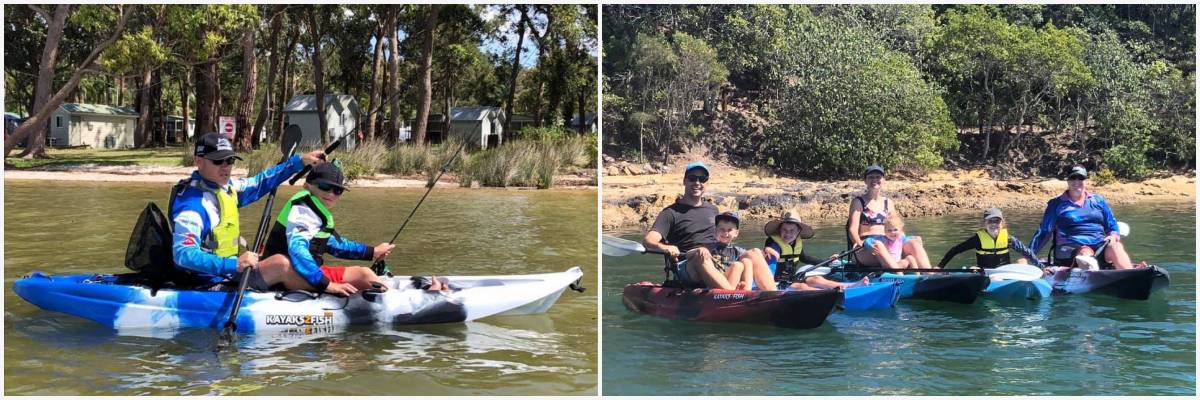
Learning the lingo of kayaking - teaching your kids to 'talk the talk'
An absolute myth is that kids don't like learning. The fact is that kids love learning new and interesting things - and they love impressing others with their knowledge. Knowing the parts of a kayak is often just as important as knowing how to handle one.
The kids guide to a kayak:
- Deck - the top part of the kayak, where you'll sit and keep all your stuff.
- Kayak Hull - the bottom section of the kayak that sits in the water.
- Stern - the back of the kayak.
- Bow - the front of the kayak.
- Foot Braces - where your feet will go when you're paddling.
- Hatch - where you can keep snacks and a drink bottle.
- Seating Area - where you'll sit when you're paddling.
- Paddle - what keeps you moving (unless you have an electric motor!).
- Paddle Holder - this stops your paddle from floating away if it falls overboard.
- Bungee Cord - these help keep everything you take tidy.
- Rear Storage - this is a handy place to put any fishing equipment or a storage container.
- Rod Holder - a handy place to hold your rod if you're fishing from the kayak.
- Scupper Holes - these are for helping the water drain from the deck.
Skills to teach your kids when they use a single kayak
Besides wearing a life jacket properly, knowing how to get in and out of a kayak while it's on the water is vital. When you're teaching your child how to get in the kayak, you can start in shallow water.
Start their training in water about waist deep, and show them how to get in the kayak successfully. As your child improves, you can slowly move the kayak to deeper water until they can get in and out where they cannot touch the bottom.
Paddling and controlling is a skill that'll come with time. If you're aware of the basics, you can teach these to your child. Most kids will need a little time to coordinate themselves properly with the paddle. Give them the time and space to figure out what works well for them, and don't be too concerned if their technique isn't a hundred per cent correct.
With time your kids will know how to get around in the kayak, and soon they'll be faster than the rest of the whole family!
Buying the right kayak for your kids
If you already have a kayak, then your kids may find room to sit on the bow and tag along. Eventually, your kids will want their own kayak so they can paddle next to you. Selecting the right kid's kayak is essential, as getting the wrong one can mean it is too big to handle, and if you get one too small, they can flip it easily.
Depending on a kayak's design, it'll have a maximum user rating. You should find a kayak that is large enough to support your child's weight but not too big that it's difficult for them to operate.
All kayaks from Kayaks2Fish will come with a standard seat and paddle, but some of the larger kayaks will come with an adult paddle. When your kids are getting started, some people consider buying an inflatable kayak, however, they're not as durable as a kayak made from high-density polyethylene.
When you're first heading out on the water with your kids in their own kayak, you may like to rig up a tow line to help them keep up with the family. The towline will also help you get them out if they get stuck where they cannot maneuver their way out (e.g., in overhanging branches).
In this chart, you'll find the basic features of all the kid's kayaks at Kayaks2Fish. These kayaks can be used as a fishing kayak and include an adjustable rod holder and two built-in rod holders (except the Puffin).
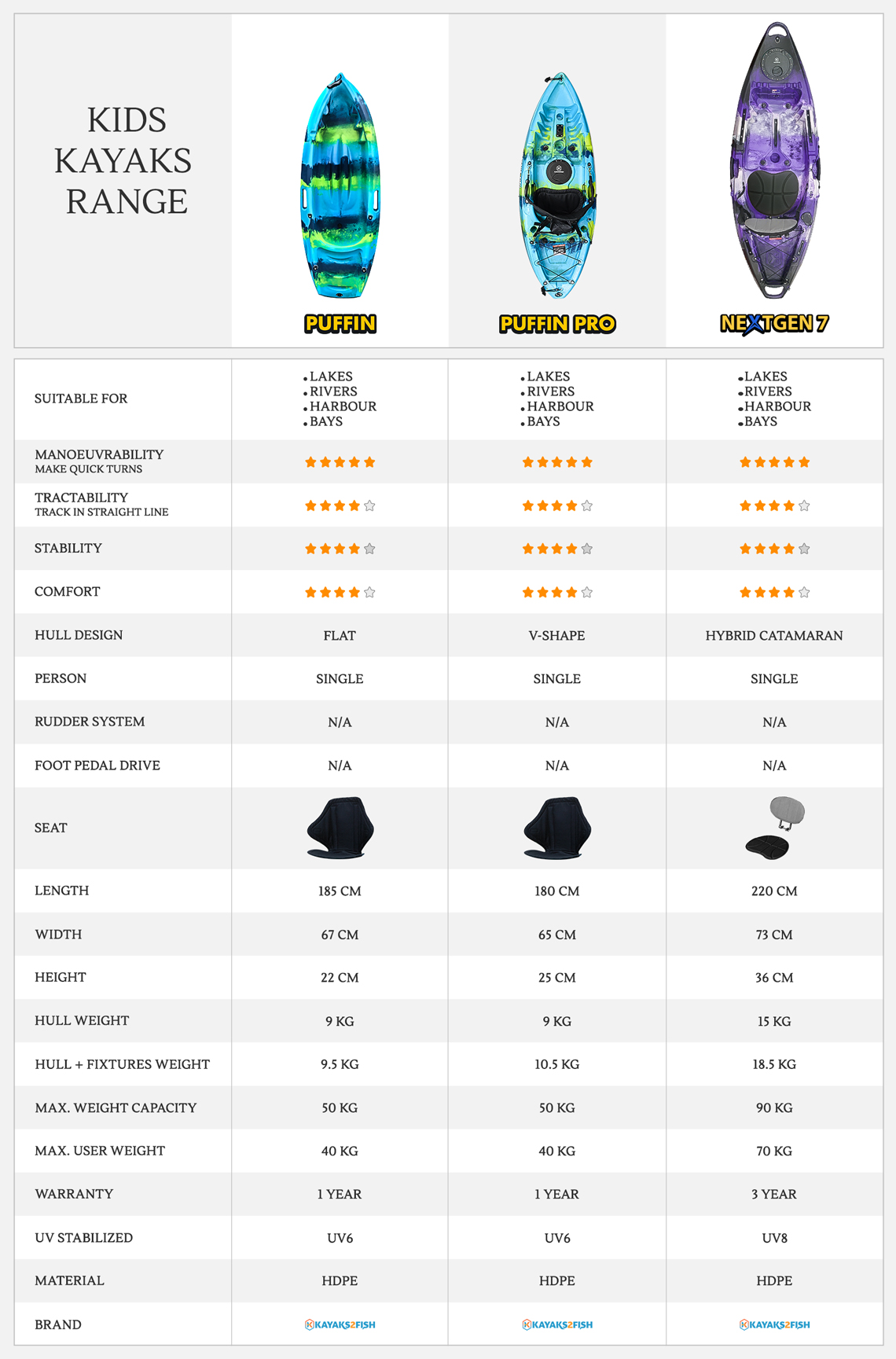
Going on kayaking adventures with kids
An experienced kayaker will know some brilliant places suitable for a kids kayak. You want places that are calm and provide a positive experience. You'll find that slow rivers are brilliant for young kayakers. These are just flowing fast enough that you don't need to worry about your kids getting tired from paddling. A river is usually protected from wind and offers good shade coverage so your kids won't get burned. You can also consider a kayak sunshade for extra protection from the sun.
river kayaking adventure
Another excellent option to take a kids kayak is any beach area that doesn't see a lot of waves (e.g., Port Phillip Bay in Melbourne). On these calm waters, your kids will get an excellent experience and maybe the chance to drop a line! Saltwater kayaking means that you need to keep a careful watch on your kids; it's best to have a few parents ready to rope in case anyone starts heading out to sea.
Using a double kayak can be perfect if you want to give your kids the option of paddling or simply sitting in the front seat and watching the world go past. If your kids are small enough - and it doesn't overload your kayak - they can ride on the front of a single kayak.
When can kids start kayaking by themselves?
Children can handle their own 'kids kayak' as soon as they have the skills needed. There are kayaks available that are very light, and that makes it easier for them to maneuver. You'll often see kids as young as six years old operating their own kayak. Kids younger than six can have their own kayak, but using a tow rope is probably a good idea. All kids will need an approved life jacket that fits properly at all times.
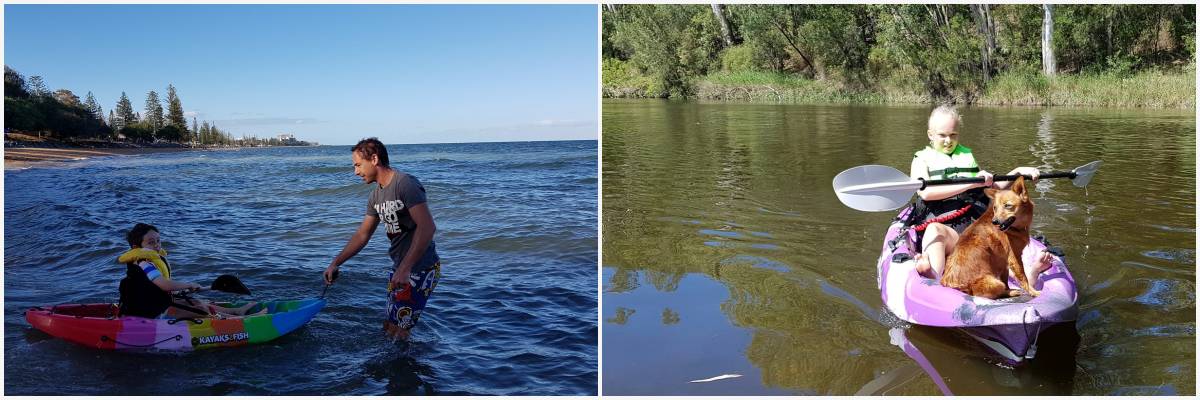
Frequently asked questions about kids kayaks
What is the best hull design for a kids kayak?
A kids kayak will come with different hull designs; flat, v-shaped, or pontoon hulls. The flat and pontoon hull offers the most stability, but they can be slow in the water.
If your child wants more speed, you can choose a v-shaped hull. The only downside for a v-shaped hull is they offer a reduced amount of stability compared to the other hull design.
At Kayaks2Fish we take a hybrid approach, our kids kayaks are designed to be very stable while providing excellent speed and maneuverability.
How do you size a kayak for a small child?
The best way to size a kids kayak is with their weight and height. All kayaks will only support a certain amount of weight, and once you go over this, they are not as stable. If you're new to kayaking, check that the overall package includes a seat and a suitable paddle.
How do you teach a child to kayak?
Teaching a kid to kayak is best done on the water. You can watch instructional videos before you head out to give them a good baseline knowledge. If you're not confident teaching them yourself, you can enrol them in the many kayaking classes available.
Is an inflatable kayak good for kids?
An inflatable kayak is a good starting point for kids as these are often low in cost. However, some may not be that durable and can get punctures easily. It is best to get a kayak made with High Density Polyethelene (HDPE) from the start to avoid having to replace the inflatable kayak later on.
Is a sit-in or a sit-on-top kayak better for kids?
For kids that are just getting started, a sit-on-top kayak is better. The sit-on-top kayak usually offers better stability, and they are easy to right and get back on board if you flip over. A sit-in kayak is better for speed, and with time your child may prefer that over the versatility of a sit-on-top kayak. However, sit-in kayaks require more experience as they can easily roll over and it is hard to get back in once overboard.
Kayaking with kids (2-6)
Kids ages 2-6 are usually reasonably keen to head out on a kayak, especially if it is something their parents already do for fun. Kayaks2Fish Puffin kids kayaks are perfect for this age group.
Can I take a young child on a kayak?
Yes. Kids as young as 2-6 years old can go kayaking. They may be too young to operate one themselves, but they can sit on the front of a single kayak (or in a double kayak) operated by an adult.
When can my child control a kayak by themselves?
Kids are capable of handling a kayak at all different ages. Usually, if your child is asking for their own kayak, they are ready for the challenge. You can use a tow rope if you feel they need assistance keeping up with the whole family.
Kayaking with school-aged children (6-12)
At ages of 6-12 years, your child is old enough to handle a kayak independently. However, you'll still need a parent to provide assistance and guidance. Kayaks2Fish Puffin Pro kids kayaks are perfect for this age group.
Should a school-aged child have their own kayak?
It depends. Kids mature at different rates, and at 6-12 years old, they may need to feel a hundred per cent confident. However, most are capable of operating their own kayak. It is best to ask what they would prefer. If you've been using a double kayak, they may not want a single kayak.
Can my child use a fishing kayak?
Yes. Kayaks2Fish Puffin Pro kayaks designed for a 6-12 years old child are stable and have suitable storage spaces to be used as a fishing kayak. Kayaking is an excellent way to get your child interested in fishing.
Kayaking with teenage children (13-17)
If your teenage child enjoys the outdoors, fishing or sport, then they'll probably enjoy getting out on a kayak. With older kids testing the waters with a rental kayak can be the best introduction.
Many kids this age are looking to increase their independence. When heading out with you, they may prefer to head off exploring. Just make sure they have a phone in a waterproof case, and they'll be fine. Kayaks2fish NextGen 7 kayaks are perfect for youth and young adults.
Should my teenager use a junior or adult kayak?
Almost all children over the age of thirteen can use an adult-sized kayak. It can be the perfect excuse to buy yourself a new one or upgrade to a paddle kayak.
Do teenagers like kayaking?
A teenager may prefer going out with people their own age when kayaking. If you have a club nearby, or some of their friends have shown an interest, it's a good bet that they'll enjoy it.
Where to buy the best kids kayaks?
At Kayaks2Fish, you'll find an excellent range of kids kayaks. All our kayaks are available in various colours, a comfortable seat, and a suitable paddle. These kayaks are fitted with carrying handles to help you get them to the water, and most models can be fitted with a kayak trolley.
You can order the kayaks through our online shop, and these can be shipped to your door for most locations in Australia. If you want to save on shipping costs, you can collect them from any one of our warehouse locations (Melbourne, Sydney, Brisbane, Adelaide, Perth, etc.).
The kayaks from Kayaks2Fish are suitable for all ages and skill levels and can go in lakes, rivers, dams, estuaries, bays, and harbours. We provide the user with a stable platform to fish from and are brilliant for kids to learn the art of kayaking.





